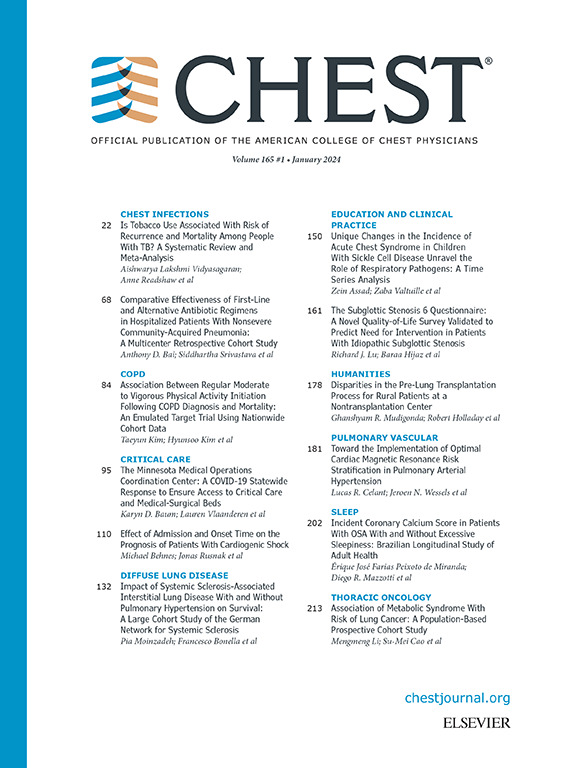围手术期使用肺动脉导管对心脏手术临床结果的影响:全国队列研究
IF 9.5
1区 医学
Q1 CRITICAL CARE MEDICINE
引用次数: 0
摘要
研究问题围手术期使用肺动脉导管(PAC)是否会降低心脏手术患者的 1 年全因死亡率?研究设计和方法这项基于人群的全国性队列研究利用韩国健康保险索赔数据库纳入了 2011 年 1 月至 2020 年 12 月期间在韩国接受心脏手术的所有成年患者。我们对主要结果--围术期使用和未使用 PAC 的患者(分别为使用 PAC 组和未使用 PAC 组)的 1 年全因死亡率风险进行了比较,采用的是经过稳定的逆治疗概率加权后的逻辑回归分析。结果共分析了 61,405 例患者。PAC组的1年全因死亡风险明显低于无PAC组(调整后的几率比[OR]为0.81;95%置信区间[CI]为0.76-0.86)。在亚组分析中,心脏手术类型和机构病例量都被认为是显著的调节因素(交互作用的 P 均<0.001)。具体来说,与无 PAC 组相比,PAC 组在进行孤立的非泵冠状动脉旁路移植术后 1 年全因死亡风险明显降低(调整 OR,0.54;95% CI,0.48-0.61)。在病例量最低的中心(<100 例/年;OR,0.70;95% CI,0.65-0.76),使用 PAC 可显著降低术后 1 年全因死亡的风险。这种关联主要是由接受非泵冠状动脉旁路移植术的患者和在经验较少的中心接受心脏手术的患者造成的。本文章由计算机程序翻译,如有差异,请以英文原文为准。
Impact of Perioperative Pulmonary Artery Catheter Use on Clinical Outcomes Following Cardiac Surgery: A Nationwide Cohort Study.
BACKGROUND
Evidence on the effectiveness of pulmonary artery catheters (PACs) in cardiac surgery is scarce.
RESEARCH QUESTION
Does perioperative PAC use decrease on 1-year all-cause mortality in patients undergoing cardiac surgery?
STUDY DESIGN AND METHODS
This nationwide, population-based cohort study included all adult patients who underwent cardiac surgery in Korea between January 2011 and December 2020 using a Korean health insurance claim database. We compared the primary outcome, the risk of 1-year all-cause mortality, between patients with and without perioperative use of PACs (PAC and no-PAC groups, respectively) using logistic regression analysis after stabilized inverse probability of treatment weighting. A subgroup analysis was performed to determine whether the association varied according to the type of cardiac surgery and institutional case volume.
RESULTS
A total of 61,405 patients were analyzed. The PAC group had a significantly lower risk of 1-year all-cause mortality than that in the no-PAC group (adjusted odds ratio [OR], 0.81; 95% confidence interval [CI], 0.76-0.86). In the subgroup analysis, both the type of cardiac surgery and institutional case volume were identified as significant modifiers (all P for interaction<0.001). Specifically, the PAC group had a significantly lower risk of 1-year all-cause mortality following isolated off-pump coronary artery bypass grafting (adjusted OR, 0.54; 95% CI, 0.48-0.61) compared to the no-PAC group. PAC use was associated with a significant reduction in the risk of 1-year all-cause mortality in the lowest-case volume centers (<100 cases/year; OR, 0.70; 95% CI, 0.65-0.76).
INTERPRETATION
Perioperative use of PACs was associated with a significant reduction in the risk of postoperative 1-year all-cause mortality. This association was predominantly driven by patients who underwent off-pump coronary artery bypass grafting and those who underwent cardiac surgery in less experienced centers.
求助全文
通过发布文献求助,成功后即可免费获取论文全文。
去求助
来源期刊

Chest
医学-呼吸系统
CiteScore
13.70
自引率
3.10%
发文量
3369
审稿时长
15 days
期刊介绍:
At CHEST, our mission is to revolutionize patient care through the collaboration of multidisciplinary clinicians in the fields of pulmonary, critical care, and sleep medicine. We achieve this by publishing cutting-edge clinical research that addresses current challenges and brings forth future advancements. To enhance understanding in a rapidly evolving field, CHEST also features review articles, commentaries, and facilitates discussions on emerging controversies. We place great emphasis on scientific rigor, employing a rigorous peer review process, and ensuring all accepted content is published online within two weeks.
 求助内容:
求助内容: 应助结果提醒方式:
应助结果提醒方式:


